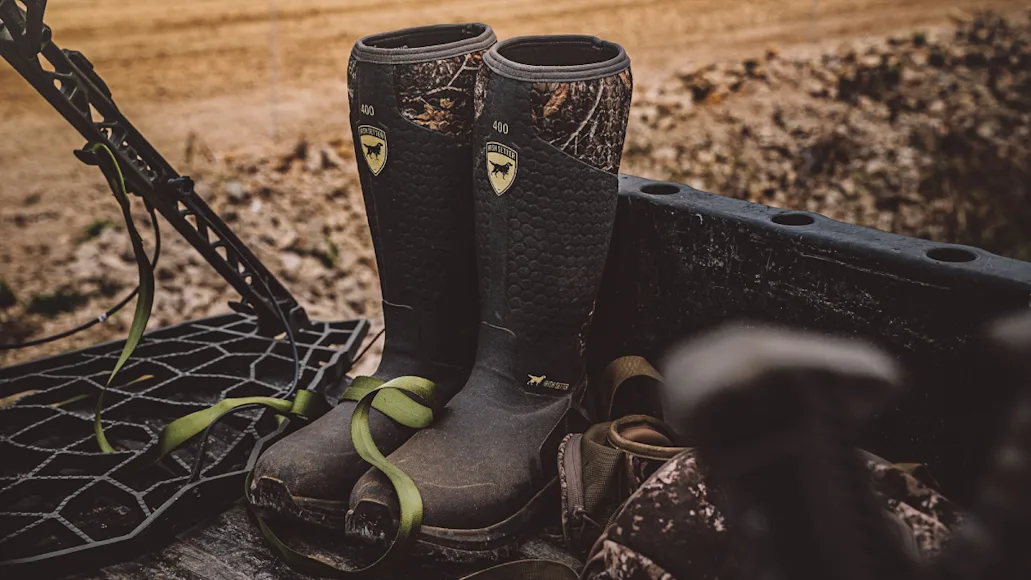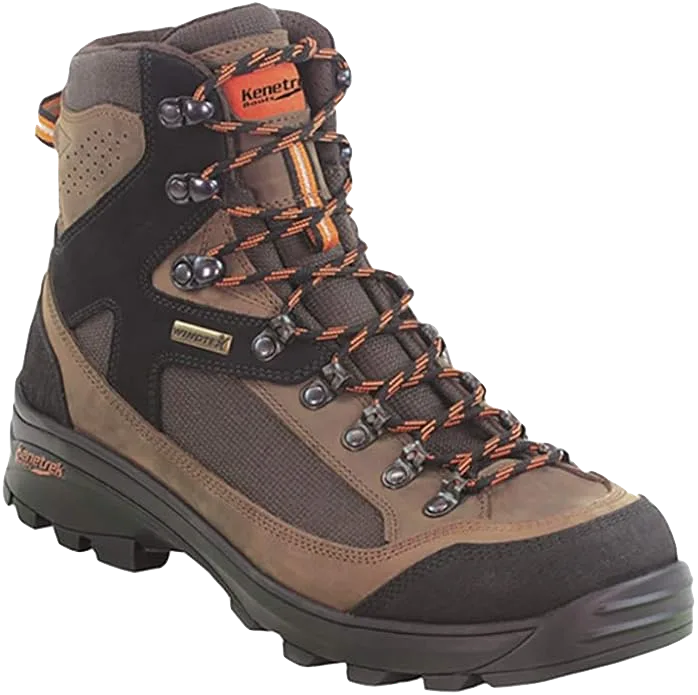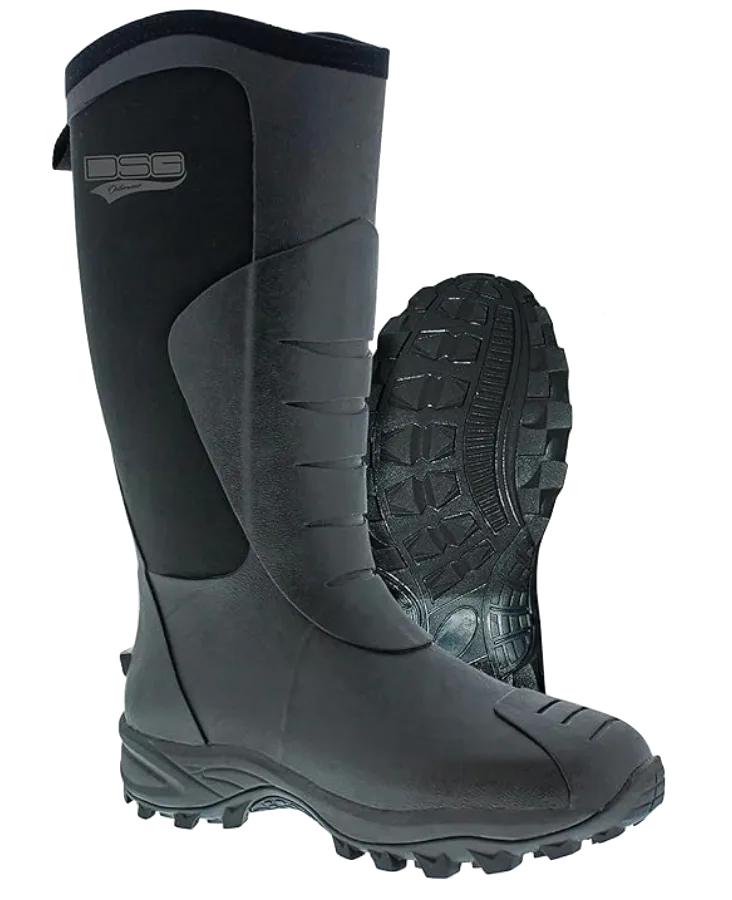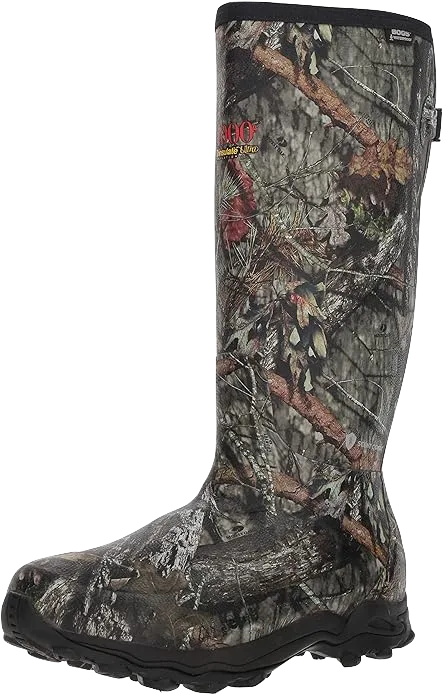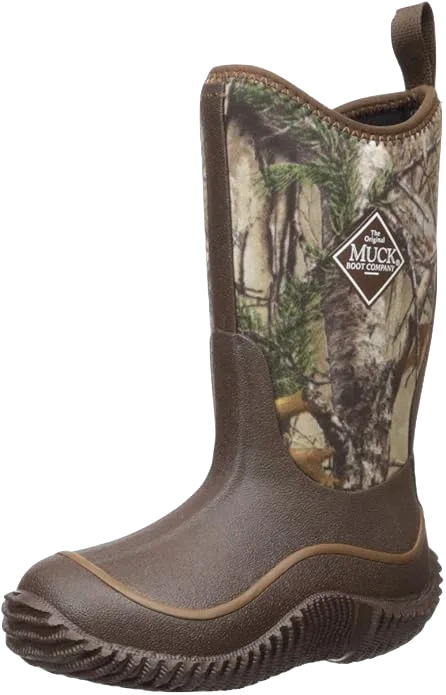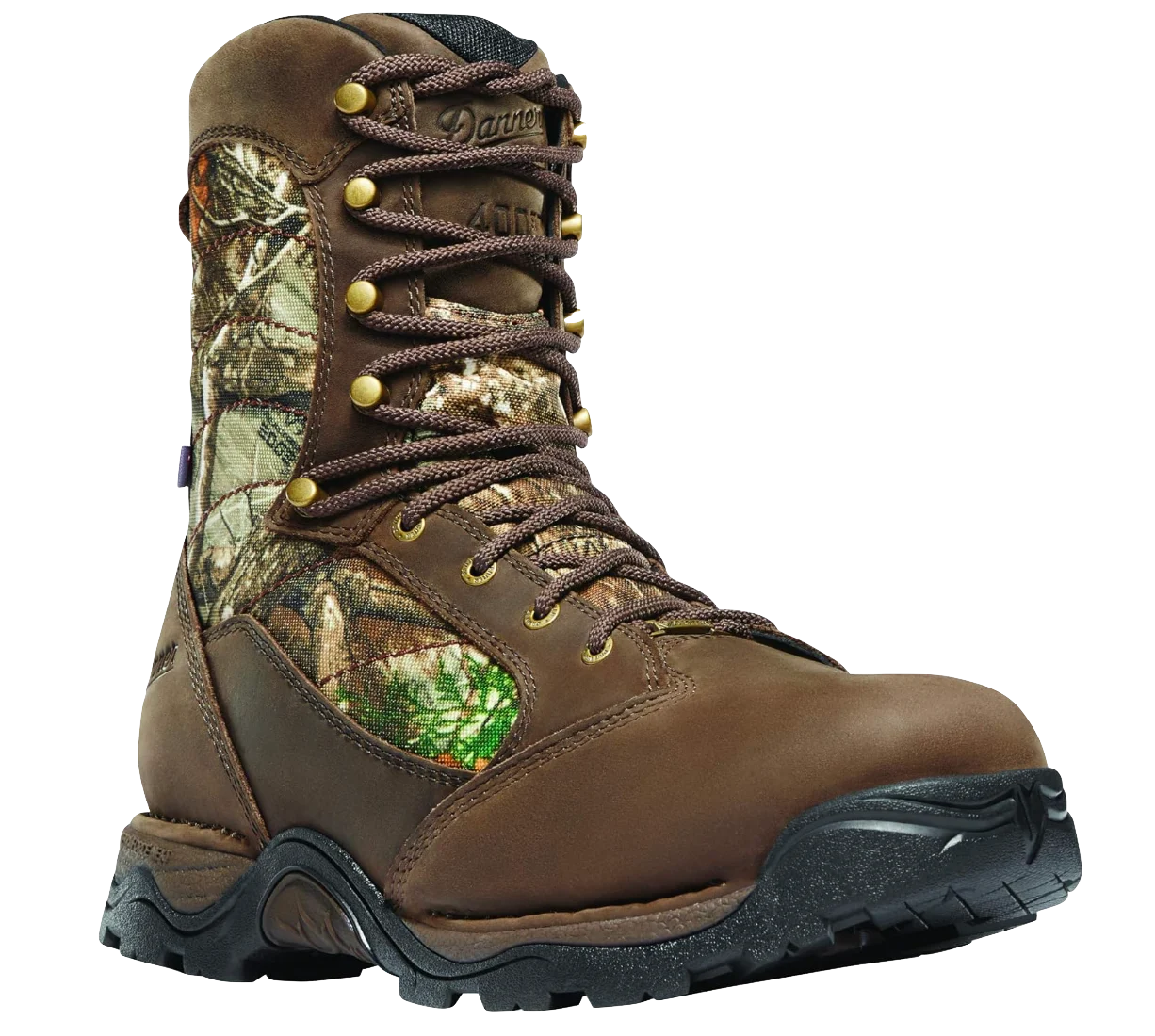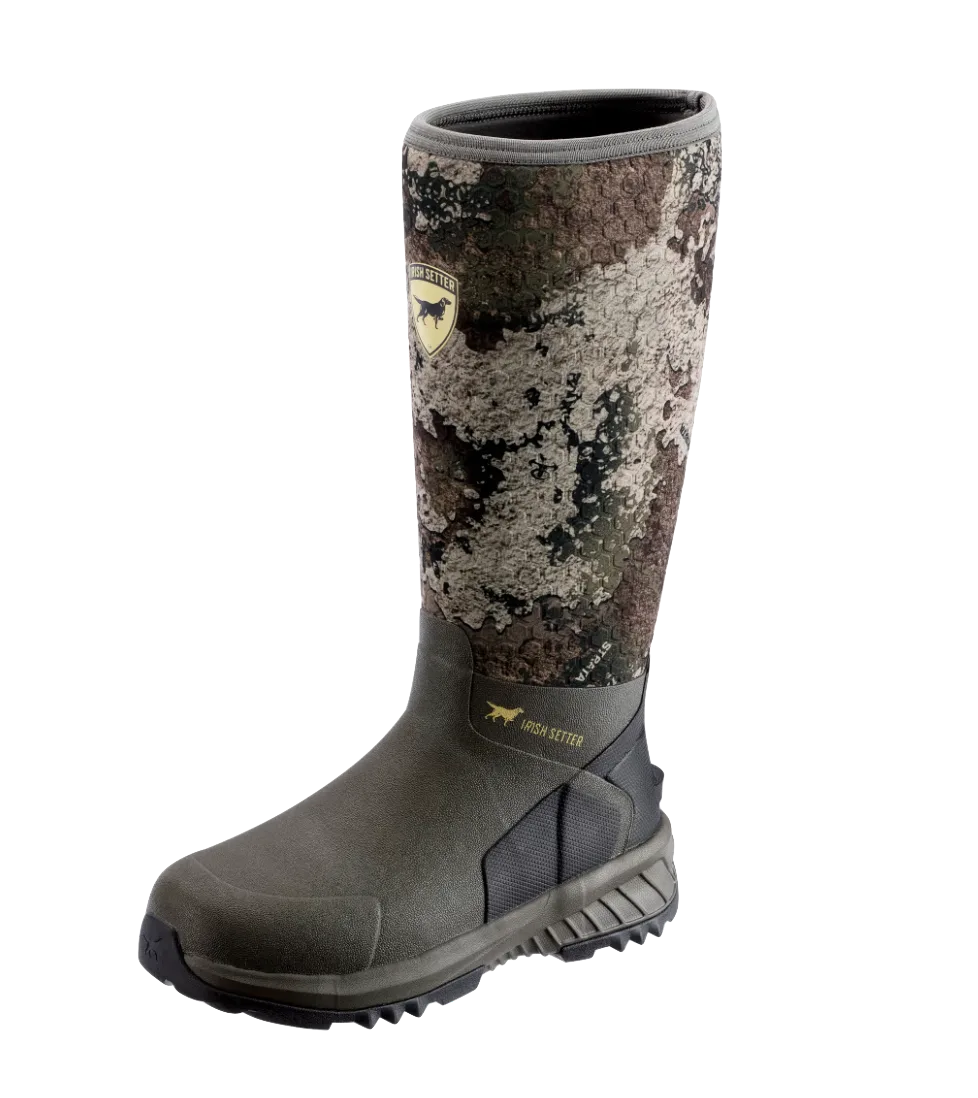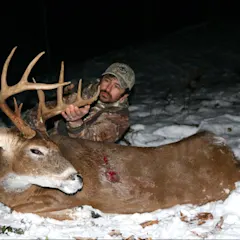We may earn revenue from the products available on this page and participate in affiliate programs. Learn more ›
Hunting boots are arguably the most important piece of hunting equipment besides your compound bow, rifle, or shotgun. If your feet aren’t happy, you won’t be happy. Fortunately, similar to a good hunting jacket, investing in a strong pair of hunting boots can make sure you remain comfortable throughout your entire hunt.
The best hunting boots are the ones that can handle the terrain that the game you’re chasing lives in, letting you move along as effortlessly as possible in that pursuit. They should keep your feet warm, dry, and comfortable. And they should be durable enough to do the job season after season. Here are our favorite hunting boots for different situations.
Best for Men: Kenetrek Corrie 3.2 Hiker
Best for Women: DSG Women’s Insulated Rubber Boot
Best for Late Season: Zamberlan Sawtooth Thermal Boots
Best Lightweight: Irish Setter Vaprtrek
Best Waterproof: Bogs Blaze II
Best for Kids: Muck Kid’s Hale Camo
How We Picked the Best Hunting Boots
I spend several months in the field each year as a hunter and outdoor content creator. Throughout the years, I’ve worn many different hunting boots, testing some and hunting with others. I drew on this experience to create my list of best hunting boots. In addition to the things to consider listed above, I kept the following in mind:
Intended use: Does this boot fit the hunting style it was built for? Can it handle the terrain it will likely encounter? Will they handle the climate and weather?
Affordability: You can spend an outrageous amount on hunting boots, but that’s no guarantee that they will keep your feet warm, dry, and comfortable. I selected boots that will perform well, but not break the bank.
Durability: Can these boots handle the rough conditions encountered while hunting? Are the materials up to it? How long will they last?
Best for Men: Kenetrek Corrie 3.2 Hiker
Specs
Height: 7 inches
Materials: Leather
Insulation: None
Weight: 3.2 pounds (pair)
Outsole: Lug
Pros:
Ankle support K-straps
Reinforced double and triple stitching in high-wear areas
Waterproof and breathable
5mm nylon insoles
Cons:
High price
No camo
Kenetrek makes some great hiking boots, so it’s no surprise the Kenetrek Corrie 3.2 Hiker takes top honors as the Best Overall Men’s Hunting Boot—we also dubbed it the best turkey hunting boot out there. The company started with its Mountain Boot and made modifications to bring you this new-and-improved model. Some 20 years of testing culminate in what might be the ultimate boot for hunters that put on serious miles over serious terrain.
Though these boots are only 7 inches tall and weigh 3.2 pounds, they offer plenty of support. Some of this comes courtesy of K-straps that tie the base to the heel, which prevent your ankles from rolling without being intrusive. For even more support in rugged topography, Kenetrek tucked 5mm nylon insoles into the build.
The Windtex membrane keeps the boots waterproof while offering a high level of breathability. Durability ranks highly, too. The Corrie 3.2 features reinforced rubber toes and heel guards, which boost abrasion resistance. Reinforced double and triple stitching in high-wear areas also adds to the long-life potential. —Jace Bauserman
Best for Women: DSG Women’s Insulated Rubber Boot
Specs
Height: 16 inches
Materials: Neoprene and rubber
Insulation: 1,200 grams of Thinsulate
Weight: 4 pounds (pair)
Outsole: Lug
Pros:
True women’s fit
Waterproof
Removable 5mm wool felt insole
Cons:
All-rubber design can restrict mobility compared to other designs
Pricier option
The DSG Women’s Insulated Rubber Boot is new to the DSG lineup, but it’s already proven itself as an excellent cold-weather hunting boot for women. Unlike many designs that are built on scaled-down versions of men’s lasts, these were built from the ground up with women in mind. These provide a true women’s fit that will remain comfortable mile after mile.
This 100 percent waterproof boot is made from neoprene and rubber with 1,200 grams of Thinsulate insulation, so it’s great for colder hunts. It also includes a moisture-wicking 5mm wool felt insole to help increase warmth while afield but removes easily to dry quickly as soon as you get home. An aggressive lug sole provides plenty of traction, keeping you sure-footed on even slippery surfaces like ice or loose gravel. A shin guard overlay adds durability and protection. —J.B.
Best for Late Season: Zamberlan Sawtooth Thermal Boots
Specs
Height: 11 inches
Materials: Nubuck leather with Hydrobloc treatment/Waterproof
Insulation: N/A
Weight: N/A
Outsole: Zamberlan Vibram StarTrek II
Pros
Very warm
Comfortable
Excellent traction
Great for deep snow
Cons
Slightly heavy
Expensive
The Zamberlan Sawtooth boots are the best late-season hunting boots you can buy. Period. I wore the Sawtooth boots on a mid-November seven-day backcountry mule deer hunt. Over the course of the week, I hiked over 30 miles, trudging through deep snow, mud, and sagebrush. Not to mention the steep and rugged terrain of the Rocky Mountains. The Sawtooths handled it all with ease, keeping my feet warm and comfortable the entire time.
Temperatures dipped into the single digits, but I never even reached for toe warmers. I was also expecting blisters by the end of my hunt, but they never came. The boots are 11 inches tall, which helps with stability and walking through deep snow. This also helps prevent you from rolling your ankle in the field. The aggressive treads are ideal for rugged terrain, snow, and ice. I never slipped, even in over a foot of snow.
Normally, these boots cost $525 but they're sometimes on sale at Cabela's for as low as $460. No matter which way you cut it, the Sawtooths are expensive hunting boots. Given the price, insulation, and aggressive tread, I recommend buying them for late-season Western big game hunts. It was one of the most important pieces of gear on my backcountry hunt, and now I won't hunt in cold and snowy conditions without them. —Ryan Chelius
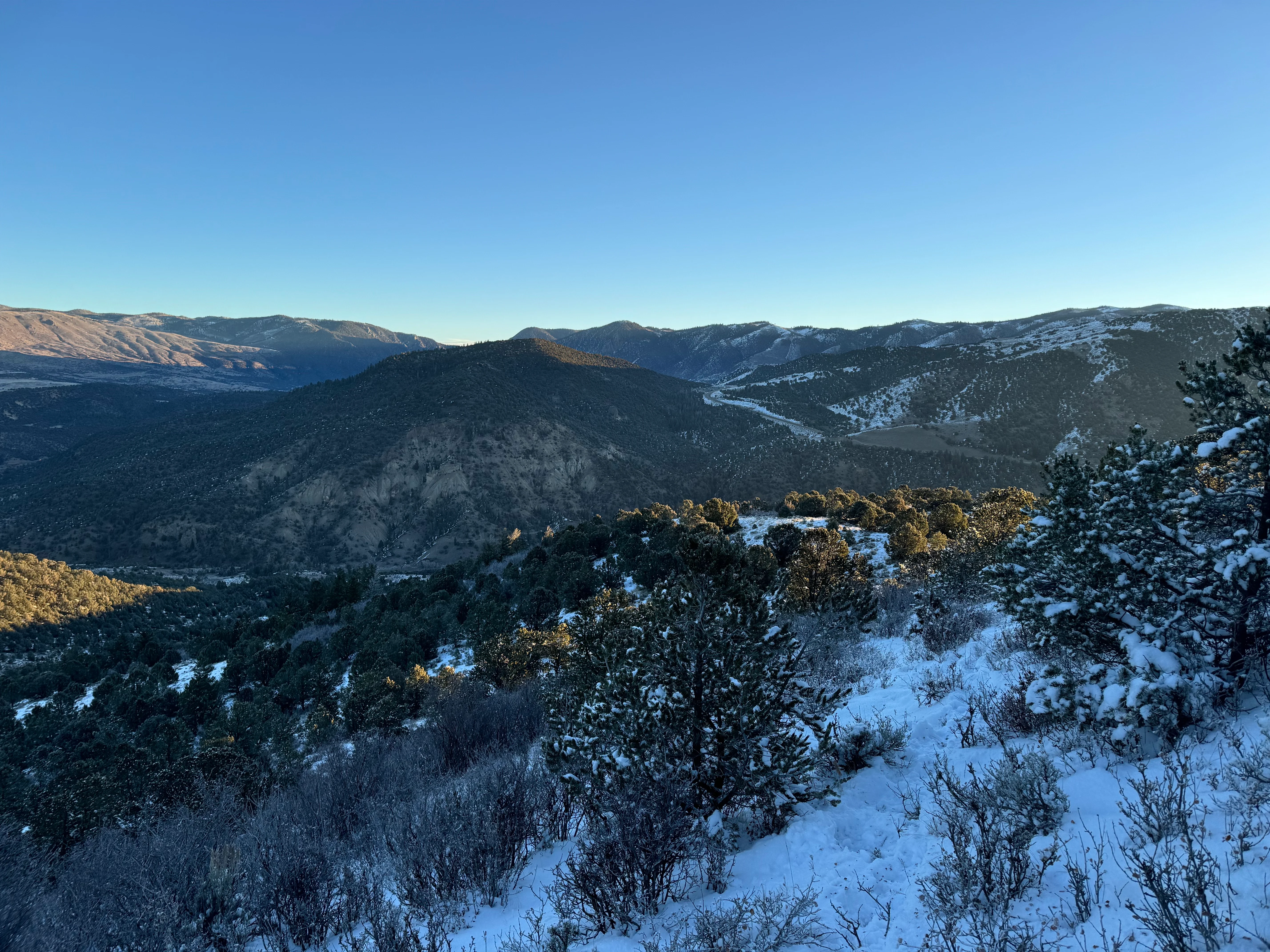
Best Lightweight: Irish Setter Vaprtrek
Specs
Height: 8 inches
Materials: Full-grain leather and abrasion-resistant mesh
Insulation: None
Weight: 2.25 pounds (pair)
Outsole: Aggressive lug design
Pros:
Waterproof
Scent-reduction technology
Quality arch design
Cons:
Short height doesn’t provide as much ankle support as taller designs
The Irish Setter Vaprtrek is the king of the featherweights. The boot is tailor-made for deer hunting, with a ScentBan lining that helps prevent odor-causing bacteria that can spook deer from building up in your boots. An aggressive outsole features tapered lugs that bite hard, but easily release mud. Wrap-around outsoles are designed to grip tree-stand rungs and ATV footholds, so you won’t have to worry about losing your footing on the go.
To keep weight down but maintain waterproofing, Irish Setter combined full-grain leather and nylon honeycomb ripstop in the boot’s upper. This 8-inch lace-up design has a removable polyurethane memory foam footbed and is fitted with a nylon shank, which offers enough support for hunters who will encounter moderate terrain but is a bit lacking for those who tackle the steepest inclines. —J.B.
Best Waterproof: Bogs Blaze II
Specs
Height: 16 inches
Materials: Neoprene and rubber
Insulation: 1,000 grams of Thinsulate
Weight: 5.5 pounds (pair)
Outsole: Bob
Pros:
Rubber and neoprene construction is impervious and durable
Comfort rated to -40 degrees Fahrenheit
Technology that fights odors
Moisture wicking
Cons:
Heavier than many rubber boot models
Pricier than the average boot
Virtually all rubber hunting boots are waterproof, so the category for best waterproof hunting boots came down to superior design and standout features. The Bogs Blaze II not only keeps water out but also uses technology to keep sweat wicked away on the inside, too. This helps keep you blister-free and comfortable, while also combating scent that can keep game away. The wicking properties and 1,000 grams of Thinsulate give this boot a comfort rating all the way down to -40 degrees Fahrenheit, though that might be a bit unrealistic if you’re not moving.
The exterior is constructed from a combination of rubber and neoprene, which makes them 100 percent waterproof. This pairing is also more durable than neoprene alone, helping them fend off briars and barbed wire. You pay for this in weight, though, as they are heavier than models made from just rubber or neoprene. Still, the Blaze II will likely remain waterproof long after other market options begin leaking. —J.B.
Best for Kids: Muck Kid’s Hale Camo
Specs
Height: 10 inches
Materials: Neoprene and rubber
Insulation: 4mm neoprene
Weight: 1 pound (pair)
Outsole: Ribbed
Pros:
100 percent waterproof
Wide opening for easy on and off
Breathable mesh lining
Ranges from size 2-13
Cons:
No half sizes
No calf adjustments
The Kid’s Hale in Camo by The Muck Boot Company is designed to protect feet from getting wet, muddy, or cold. This pair of boots is comfort-rated from subfreezing temperatures to 65 degrees. It incorporates heat-retaining, 4mm flex-foam neoprene for comfort and longevity. And a high-grade rubber exterior increases durability and waterproofing, too. Thanks to a self-cleaning ribbed outsole, it’s easier to keep the mud and muck from building up on the boot.
The exterior keeps water out, while the inner mesh lining helps wick sweat and moisture away from the foot. And an anti-microbial footbed insert helps reduce scent, so you won’t need to keep these outside if the little ones get to running in the summer heat. It also has a back tab for pulling the boot on and off, and a wide opening so the kid’s won’t need your help. —J.B.
Danner Pronghorn Hunting Boots
Specs
Height: 8 inches
Materials: Full-grain leather and nylon
Insulation: 400 grams of PrimaLoft
Weight: 3.5 pounds (pair)
Outsole: Vibram Pronghorn
Pros:
Very comfortable
Waterproof and breathable Gore-Tex liner
Comfortable, durable midsole and rugged outsole
Cons:
Higher pricing
Minimal insulation
The Danner Pronghorn is a top-end boot, with specs to match. One of Danner’s longest-running lines thanks to a loyal customer base, the Pronghorn includes a polyurethane footbed, bi-fit board shank, waterproof/breathable Gore-Tex lining, and 400 grams of PrimaLoft insulation. Though it only has a height of 8 inches, it provides the support needed for rugged terrain.
The support begins at the bottom, with an internal/external shank system that provides optimal arch support and torsion control. The Pronghorn also has a Vibram rubberized midsole. This maintains the same cushioning properties as traditional EVA for comfort over long distances, yet it’s more durable for a longer life. This boot also features a rugged Vibram outsole, which does well in varying terrain.
The only knock against the Pronghorn is the insulation. The 400 grams of Primaloft are good for moderately chilly mornings and won’t overheat your feet on the go, but may prove a little light for long sits. The Pronghorn fits great, comes in camo, and has a 365-day warranty. —J.B.
Irish Setter MudTrek
Specs
Height: 17 inches
Materials: Vulcanized rubber
Insulation: 1,200 grams of ThermoBoost
Weight: 4.4 pounds (pair)
Outsole: Lug
Pros:
ScentBan anti-microbial coating
TempSense thermoregulation technology
3D fleece lining
Heel kick
Cons:
Expensive pricing
Minimal width availability
Hunters looking for the best rubber hunting boots that receive high marks in all metrics should consider the 17-inch Irish Setter MudTrek. It sets the bar. Of course, it’s 100 percent waterproof, and it keeps feet warm with 1,200 grams of ThermoBoost insulation. Its TempSens technology reacts to the foot’s body temperature and sweat level, helping keeping feet dry. And the ScentBan odor-control anti-microbial coating helps reduce bacteria and eliminate odor.
It’s also a very tough and durable boot, sporting vulcanized rubber that lasts. And don’t forget about this boot’s comfort level. It has a 3D fleece lining interior, and a design that hugs the foot, yet allows it to move as you ease across the landscape. And it’s the little things that make the difference: a well-designed heel kick lets you take the boot off with ease. —J.B.
What to Consider When Choosing Hunting Boots
Keeping the following things in mind will help make the correct selection for you and your hunting needs.
How You Hunt
How and where you hunt plays a big role in selecting the correct boots for you. Think about how you hunt, the terrain you cover, and then review the following criteria.
How much walking you will do: Elk hunters out West will cover a lot more ground than the average whitetail hunter back East, so you should pick your boots accordingly. If you rack up the miles, you’re going to need a lightweight boot that provides plenty of support without weighing you down. You’ll sacrifice a little durability when you purchase boots constructed with lightweight materials, but if high-mileage hunts are the norm, you want boots that weigh as little as possible without sacrificing support.
The type of terrain you’ll be hunting in: How difficult the terrain you’re crossing determines how much support you’re going to require from your boots. If you’re walking up coveys of quail in the flatlands you won’t need the same level of support that those scaling near-vertical cliffs for sheep or mountain goats do. The ground itself also dictates what type of sole you’ll need. Bob soles excel in muddy conditions, and aggressive Vibram outsoles grip rocks and other unforgiving surfaces to keep you right side up when the going gets tough.
Whether or not you’ll be crossing bodies of water: Pretty much any hunting boot can handle the occasional dunk, but if you’re going to be cutting across bodies of water regularly, you’ll need some serious waterproofing. Consider boots made with rubber, neoprene, or some combination of the two if you’ll be waterfowl hunting in sheet waters or traversing streams in pursuit of gobblers or deer.
Whether or not you’ll be stalking near game: The right boots can help give you a stealthy approach. If you’re going to be putting the sneak on, make sure you select boots made from scent-free materials. Sensitive soles can help you feel the forest floor, so you’ll avoid snapping that twig and sending the buck you’ve been stalking running for the hills.
The presence of potentially dangerous snakes: If you hunt in snake country, you’d be well advised to pick up a boot with some level of snake-bite protection. This adds to the cost, and weight, but an ounce of prevention is worth a pound of cure.
Materials and Construction
How the boots are constructed and what they’re built from go a long way into how they’ll perform. When looking at boots, consider the following.
Waterproofing technology: There are lots of ways to keep boots waterproof. Some of the best involve a waterproof and breathable membrane, like Gore-tex. This will let perspiration escape, keeping your feet dry from the inside out. That said, if dealing with standing water is a regular occurrence, consider a totally waterproof material like rubber or neoprene.
Moisture-wicking technology: Even if a boot is built with a breathable membrane, moisture still needs some help finding its way out. Look for models built with fabrics designed to pull moisture away from your feet. This will keep your feet dry, which goes a long way toward keeping them blister-free. It will also help with warmth.
Insulation levels: Still-hunters and stand hunters have very different insulation requirements. If you’re going to be sitting still for extended periods of time in cold weather, you need all the insulation you can get. But if you’re after Osceolas in Florida, you want as little insulation as possible.
Boot height: How tall boots are generally increases the support they offer but can limit movement. Low-cut boots are great for scrambling but fall short on really steep approaches.
Boot weight: Ounces start to feel like pounds the further you get from the truck. Choose the lightest boots you can find that still meet all the other requirements. But remember, lightweight materials often aren’t as durable as their heavier counterparts, so consider how tough the terrain is going to be on your footwear. If you’re going to be dealing with sharp scree and serious inclines, then a thick, full-grain leather upper is probably your best option. But if you’re walking the prairie looking for ditch chickens, then a lighter-weight boot that incorporates a fabric upper should work well.
Other Factors
Overall comfort: Nothing can ruin a hunt faster than blisters and hot spots, which makes comfort the most important factor when selecting boots. And perhaps nothing is more important to comfort than fit. To ensure you’re buying the best hunting boots for you, get your feet professionally measured, paying attention to both length and width. Order boots that match your feet as closely as possible to ensure they remain comfortable.
Overall durability: You want boots that will last. The most durable boots are made with full-grain, one-piece leather uppers with soles stitched directly to them. But this arrangement can be heavy and isn’t right for all types of hunting. Whatever type of boots you need, make sure they are constructed with high-quality materials. Look for fabrics with high thread counts, like 500 denier Cordura, and top-quality leather.
Camouflage wants or needs: Odds are pretty good that the color of your boots isn’t going to tip whatever game you’re pursuing off to your presence, but some added concealment never hurts. This can be especially true when chasing sharp-eyed turkeys that seem to pick out the smallest details. Decide if you need camo before you start looking for boots, as this will limit your options some.
Price range and budget: You should always buy the best gear you can afford. You’ll save in the long run if you don’t have to replace your boots every other season. Plus, quality boots tend to get better with age, breaking in the exact contours of your feet and ankles.
FAQs
Q: How tall should hunting boots be?
This depends on the hunt and the terrain you’ll be spending time in. Those who are hunting hilly and mountainous terrain might prefer a shorter boot. Hunters in snake country generally like a taller one. And those hunting around or near standing water might like a taller boot, too.
Q: How long should hunting boots last?
Some boot manufacturers offer a one-year warranty, but boots should last at least two or three seasons with moderate use, likely longer. Of course, longevity varies based on boot design, as well as frequency of use.
Q: Are leather boots good for hunting?
Some hunters prefer leather. Others like rubber. Still, some hunters prefer other options. But, yes, leather boots are good for hunting.
Q: Who makes the most comfortable hunting boots?
This is subjective, but Danner and Lacrosse are known for their comfortable hunting boots, among other brands. Generally, finding boots that fit properly will ensure comfort.
Best Hunting Boots: Final Thoughts
Those who are looking to buy a pair of hunting boots should consider what the best hunting boot is for them. This will vary from person to person. Finding the right selection is entirely dependent on the style of hunting you participate in, and will influence what you ultimately choose to purchase and wear.
Why Trust Us
For more than 125 years, Field & Stream has been providing readers with honest and authentic coverage of outdoor gear. Our writers and editors eat, sleep, and breathe the outdoors, and that passion comes through in our product reviews. You can count on F&S to keep you up to date on the best new gear. And when we write about a product—whether it’s a bass lure or a backpack—we cover the good and the bad, so you know exactly what to expect before you decide to make a purchase.

